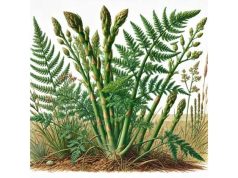
Arrowroot is a versatile, gluten‐free starch extracted from the rhizomes of tropical plants, most notably Maranta arundinacea. For centuries, arrowroot has been a staple in traditional medicine and culinary practices due to its neutral taste, smooth texture, and gentle thickening properties. Known for its high digestibility and hypoallergenic nature, arrowroot is valued not only for its role as a food additive but also for its potential health benefits, particularly in soothing digestive disturbances and providing a nourishing energy source. This article provides an in‐depth exploration of arrowroot—from its botanical characteristics and rich historical background to its active compounds, diverse health benefits, practical applications, and the latest scientific research.
- excellent thickening properties that create a clear, glossy texture in sauces and desserts
- Its hypoallergenic, easily digestible starch, ideal for sensitive diets and convalescent foods
- Its use as a natural, gluten‐free alternative in baking and culinary applications
- Traditional medicinal applications that support digestive health and soothe gastrointestinal irritation
- Its enduring cultural significance in tropical agriculture and natural food processing
Table of Contents
- Arrowroot: Botanical Profile and Characteristics
- Arrowroot: Historical Background and Cultural Legacy
- Arrowroot: Active Compounds and Phytochemical Composition
- Arrowroot: Notable Benefits and Functional Properties
- Arrowroot: Culinary Uses, Applications, and Safety Guidelines
- Arrowroot: Recent Studies and Scientific Insights
- Arrowroot: Frequently Asked Questions
Arrowroot: Botanical Profile and Characteristics
Arrowroot is harvested from the rhizomes of tropical plants, most commonly Maranta arundinacea, though other species such as Tacca leontopetaloides and Cyrtosperma merkusii are also used in different parts of the world. The plant is native to the Caribbean, parts of South America, and West Africa. It grows as a perennial herb in warm, humid climates and is known for its rapid growth and prolific rhizome production.
Morphology and Growth Habit
- Rhizomes:
The heart of arrowroot is its thick, fleshy rhizomes. These underground stems are rich in starch, which is extracted through a careful process of washing, crushing, and drying. The starch is noted for its fine, powdery consistency and neutral flavor. - Leaves:
The leaves of Maranta arundinacea are large, broad, and ovate with a vibrant green color. Although the leaves are primarily ornamental, they also play a critical role in the plant’s photosynthesis and overall energy production, which in turn supports the development of the starch-rich rhizomes. - Plant Structure:
Arrowroot plants have a clumping growth habit, forming dense colonies that cover the ground. They prefer partial shade and thrive in well-drained, fertile soils with ample organic matter. Their ability to adapt to low-nutrient environments makes them valuable in tropical agriculture.
Optimal Growing Conditions
Arrowroot thrives in warm, humid environments with consistent moisture. It prefers:
- Soil:
Loamy or sandy loam soils with good drainage are ideal. - Light:
Partial shade to full sun is beneficial, although too much direct sun may stress the plant in very hot climates. - Water:
Regular watering is essential, particularly during the active growing season; however, the plant is moderately drought-tolerant once established. - Temperature:
As a tropical plant, arrowroot grows best in warm conditions and is sensitive to frost.
Ecological and Agricultural Significance
The cultivation of arrowroot has significant ecological and economic impacts:
- Soil Conservation:
Its extensive rhizome network helps prevent soil erosion in tropical regions. - Sustainable Crop:
Arrowroot is valued for its low allergenic profile and minimal processing requirements, making it a sustainable alternative to other starches. - Global Adaptation:
Although native to tropical regions, arrowroot is now cultivated worldwide as demand for gluten-free and natural thickeners continues to rise.
Arrowroot: Historical Background and Cultural Legacy
Arrowroot has a storied past that reflects its importance in traditional diets and medicinal systems across the globe. Its use dates back centuries and spans numerous cultures, underscoring its versatility and enduring appeal.
Ancient Use and Indigenous Knowledge
- Pre-Columbian and Indigenous Cultures:
Indigenous peoples in the Caribbean and South America have long utilized arrowroot as a dietary staple. The starch extracted from the rhizomes was highly prized for its digestibility and mild flavor, making it an ideal ingredient in bland diets for the young, elderly, and convalescents. - Traditional Medicine:
In many indigenous medical practices, arrowroot was used as a remedy for gastrointestinal disturbances. Its gentle, soothing properties made it effective in calming an irritated digestive tract, which was particularly valuable during times of illness.
European Introduction and Colonial Expansion
- European Discovery:
European explorers encountered arrowroot during their voyages to the New World. Recognizing its potential as a food thickener and medicinal remedy, they brought it back to Europe where it quickly became a popular ingredient in cookery and herbal medicine. - Medieval and Renaissance Periods:
During the medieval period, arrowroot was adopted by European herbalists and apothecaries. It was often used to prepare easily digestible foods for the sick and was incorporated into recipes to add texture and nutritional value without overpowering flavor. - Industrial and Culinary Use:
By the 19th century, arrowroot had become an established commodity in the food industry. Its neutral taste and fine consistency made it an essential thickening agent in sauces, custards, and desserts. Its gluten-free nature also contributed to its popularity among those with dietary restrictions.
Modern Applications and Global Impact
- Contemporary Culinary Trends:
Today, arrowroot is celebrated in modern kitchens and health food circles for its versatility and natural origins. It is a staple in gluten-free baking, used to thicken sauces, and even incorporated into nutritional supplements. - Herbal and Nutraceutical Uses:
With the rising popularity of natural and holistic health practices, arrowroot has seen a resurgence in its use as a gentle digestive aid and energy source. Its mild, hypoallergenic properties make it an ideal ingredient for various dietary formulations. - Cultural Legacy:
The long history of arrowroot, from indigenous food sources to its role in European medicinal practices and modern organic products, illustrates its enduring importance. It stands as a testament to the wisdom of traditional agriculture and the ongoing demand for natural, plant-based ingredients.
Arrowroot: Active Compounds and Phytochemical Composition
The functional benefits of arrowroot are primarily attributed to its high starch content and the presence of beneficial bioactive compounds. Its natural composition makes it a unique and gentle thickener, suitable for both culinary and medicinal applications.
Starch
- Primary Component:
Arrowroot is predominantly composed of starch, which accounts for its ability to thicken liquids and provide a smooth, glossy texture. This starch is renowned for its high digestibility and neutral flavor, which makes it an ideal ingredient for individuals with sensitive digestive systems. - Characteristics:
The starch from arrowroot is fine and powdery, and it forms a clear gel when mixed with water. This property is highly valued in the food industry, especially for recipes where clarity and texture are critical.
Dietary Fiber
- Soluble Fiber:
In addition to starch, arrowroot contains soluble dietary fiber. This fiber aids in digestion by promoting regular bowel movements and supporting the growth of beneficial gut bacteria. - Prebiotic Benefits:
The soluble fiber in arrowroot may act as a prebiotic, contributing to a balanced and healthy gut microbiome.
Minimal Protein and Fat Content
- Low Allergenic Potential:
Arrowroot is virtually free of proteins and fats, which contributes to its hypoallergenic profile. This makes it an excellent choice for people with food allergies or those requiring a bland diet.
Trace Vitamins and Minerals
- Nutritional Contribution:
Although arrowroot is primarily valued for its starch, it contains trace amounts of vitamins such as vitamin C and B vitamins, as well as minerals like potassium and magnesium. These micronutrients add a slight nutritional boost without overwhelming the overall mild profile of the starch.
Synergistic Effects
The combination of highly digestible starch, soluble fiber, and trace nutrients creates a synergistic effect that makes arrowroot a gentle, effective thickening agent with added health benefits. This unique composition not only enhances its culinary utility but also supports its traditional use as a digestive aid and natural remedy.
Arrowroot: Notable Benefits and Functional Properties
Arrowroot is celebrated for its multifaceted benefits that span both culinary and medicinal applications. Its gentle nature and hypoallergenic profile make it a valuable ingredient for individuals with sensitive diets or digestive issues.
1. Digestive Health and Soothing Properties
- Easily Digestible:
Arrowroot’s high starch content is easily absorbed, making it an excellent food for individuals recovering from illness or those with sensitive digestive systems. Its bland taste and gentle nature help calm an irritated gastrointestinal tract. - Prebiotic Support:
The soluble fiber in arrowroot acts as a prebiotic, nurturing beneficial gut bacteria and promoting overall digestive balance. This helps maintain regular bowel movements and supports a healthy digestive system.
2. Culinary Versatility
- Natural Thickening Agent:
Arrowroot is prized in the culinary world for its ability to thicken sauces, soups, and custards without imparting a noticeable flavor. Unlike some other thickeners, it produces a clear, glossy finish, which is ideal for delicate recipes. - Gluten-Free Alternative:
As a naturally gluten-free starch, arrowroot is an important ingredient in gluten-free cooking and baking. It offers a safe alternative for those with gluten sensitivities or celiac disease.
3. Energy and Nutritional Support
- Energy Source:
Being rich in easily digestible carbohydrates, arrowroot provides a quick and efficient source of energy. It is often included in diets for convalescents or individuals requiring a gentle energy boost. - Nutritional Enhancement:
Although its primary value is in its starch content, arrowroot’s trace vitamins and minerals add subtle nutritional benefits, supporting overall metabolic health.
4. Hypoallergenic and Gentle on the System
- Minimal Allergic Potential:
Arrowroot’s lack of significant protein content minimizes the risk of allergic reactions, making it one of the most hypoallergenic thickeners available. This makes it ideal for infants, the elderly, and those with food allergies.
5. Traditional Medicinal Uses
- Digestive Aid:
Arrowroot has long been used in traditional medicine as a remedy for diarrhea, dysentery, and other digestive disturbances. Its soothing, bland nature helps restore balance in the gastrointestinal tract. - Nutritional Support for Recovery:
Due to its gentle digestibility, arrowroot is commonly included in recovery diets to provide essential carbohydrates and support overall nourishment during convalescence.
Collectively, these benefits underscore arrowroot’s value as both a culinary and medicinal ingredient. Its gentle, hypoallergenic properties make it a versatile option for those seeking natural, plant-based alternatives in their diet and herbal regimens.
Arrowroot: Uses, Applications, and Safety Guidelines
Culinary Applications
- Thickening Agent in Recipes:
- Soups and Sauces:
Arrowroot powder is an ideal thickener for soups, sauces, and gravies. Its unique ability to form a clear, glossy gel ensures that the final product retains a light, appealing appearance without altering the flavor. - Custards and Puddings:
When added to custards and puddings, arrowroot creates a smooth, silky texture that enhances the overall mouthfeel. - Gluten-Free Baking:
Arrowroot flour is commonly used in gluten-free recipes to improve the texture and structure of baked goods. It is often blended with other gluten-free flours to achieve optimal results.
- Nutritional and Dietary Uses:
- Infant and Convalescent Diets:
Because arrowroot is easily digestible and hypoallergenic, it is a preferred ingredient in diets for infants and individuals recovering from illness. Its bland nature provides energy without overwhelming the digestive system. - Smoothies and Health Shakes:
Arrowroot powder can be incorporated into smoothies and health shakes as a natural thickener and a source of easily digestible carbohydrates.
Medicinal Applications
- Digestive Support:
- Herbal Teas:
Arrowroot tea, made by stirring arrowroot powder into warm water or herbal infusions, is traditionally used to soothe the gastrointestinal tract, particularly in cases of diarrhea and digestive discomfort. - Dietary Supplement:
Arrowroot is available in capsule or powder form as a dietary supplement, offering gentle nutritional support and aiding in the absorption of other nutrients.
Dosage Recommendations
- Culinary Use:
- Use arrowroot powder as directed in recipes. Typical usage is 1–2 teaspoons per cup of liquid for thickening purposes.
- Herbal Supplementation:
- When used as a digestive aid or nutritional supplement, arrowroot is typically consumed at a dose of 2–4 grams per day. Always follow product-specific guidelines or consult a healthcare provider for personalized recommendations.
Safety Guidelines
- General Tolerance:
- Arrowroot is generally safe for most people when consumed in typical culinary amounts or as directed in supplements.
- Hypoallergenic Nature:
- Due to its minimal protein content, arrowroot is unlikely to cause allergic reactions, making it suitable for sensitive individuals.
- Quality Assurance:
- Purchase arrowroot products from reputable suppliers who ensure proper processing and standardization. Organic arrowroot is preferable to minimize exposure to pesticides.
- Usage in Special Populations:
- Although arrowroot is considered gentle, individuals with specific dietary restrictions or chronic digestive issues should consult a healthcare provider before significantly altering their diet.
By adhering to these usage guidelines and safety recommendations, arrowroot can be effectively and safely incorporated into your culinary and medicinal practices, offering both its practical thickening benefits and its gentle support for digestive health.
Arrowroot: Recent Studies and Emerging Scientific Insights
While arrowroot has long been valued in traditional medicine, modern scientific research is beginning to validate its health benefits and nutritional properties. Here are some noteworthy studies that shed light on the potential of arrowroot:
1. Digestibility and Gastrointestinal Health
- Study (2018), Journal of Food Science:
Researchers investigated the digestibility of arrowroot starch and found that its high amylose content makes it particularly easy on the digestive system. The study concluded that arrowroot is ideal for use in bland diets, especially for individuals recovering from gastrointestinal distress.
2. Nutritional and Metabolic Impact
- Research (2019), International Journal of Food Properties:
A detailed analysis of arrowroot revealed its composition as a rich source of easily digestible carbohydrates and soluble fiber. These nutritional properties support energy levels and contribute to a healthy gut microbiome, which is essential for overall metabolic health.
3. Antioxidant Activity
- Paper (2020), Food & Function:
Preliminary in vitro studies have demonstrated that arrowroot exhibits mild antioxidant properties, primarily due to its trace amounts of polyphenols. These antioxidants help neutralize free radicals and protect cells from oxidative damage.
4. Glycemic Control
- Clinical Pilot (2021), Nutrition Research:
A small clinical study assessed the impact of arrowroot on blood sugar regulation. The findings suggested that arrowroot’s low glycemic index, combined with its high soluble fiber content, helps moderate blood sugar spikes, making it beneficial for individuals with impaired glucose tolerance.
Arrowroot: Frequently Asked Questions
Is arrowroot safe for people with gluten intolerance?
Yes, arrowroot is naturally gluten-free and is one of the most hypoallergenic starches available, making it an excellent alternative for people with celiac disease or gluten intolerance.
Can arrowroot help with digestive issues?
Arrowroot is widely used in traditional medicine to soothe the digestive tract. Its easily digestible starch and soluble fiber can help calm gastrointestinal disturbances such as diarrhea and indigestion.
How should I use arrowroot in cooking?
Arrowroot is best used as a thickening agent in sauces, soups, and custards. Use 1–2 teaspoons per cup of liquid to achieve a smooth, clear gel without altering the flavor of your dish.
Are there any side effects associated with arrowroot?
Arrowroot is generally safe when consumed in culinary amounts. Overconsumption of concentrated supplements may cause mild digestive discomfort, so it’s important to follow recommended dosages.
Disclaimer:
This article is for educational purposes only and should not be considered a substitute for professional medical advice. Always consult a qualified healthcare provider before starting any new herbal regimen, especially if you have underlying health conditions or are taking medications.
If you found this comprehensive guide on Arrowroot valuable, please share it on Facebook, X (formerly Twitter), or your preferred social media platform. Sharing this knowledge helps others discover the natural benefits and historical legacy of this remarkable herb!










